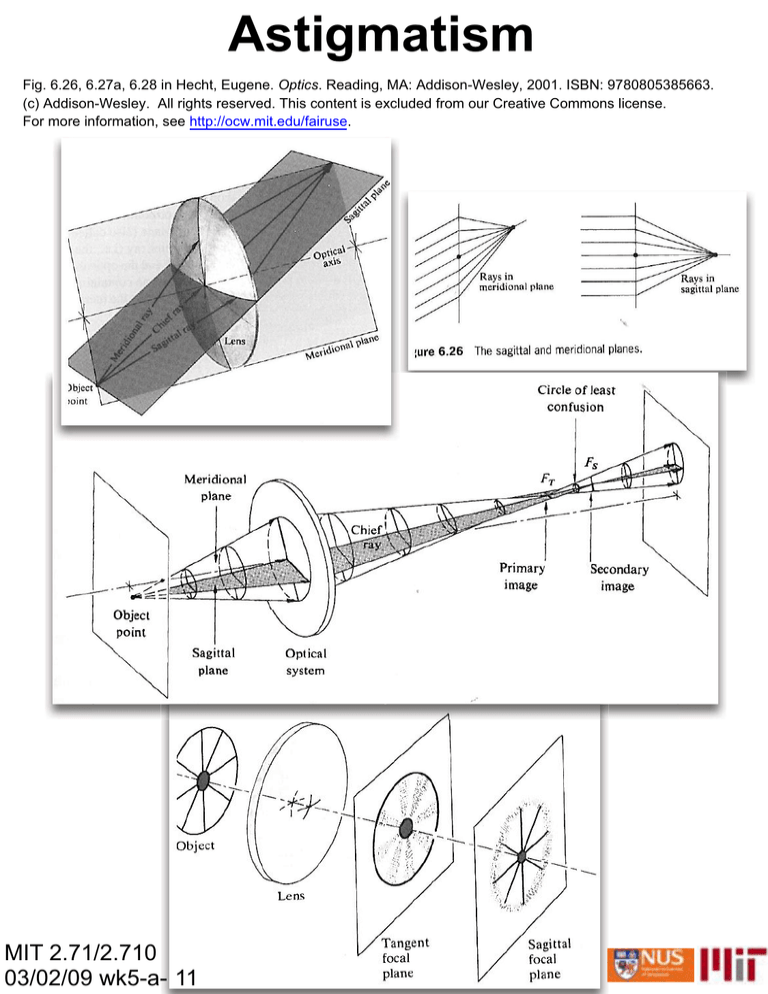
Astigmatism
Fig. 6.26, 6.27a, 6.28 in Hecht, Eugene. Optics. Reading, MA: Addison-Wesley, 2001. ISBN: 9780805385663.
(c) Addison-Wesley. All rights reserved. This content is excluded from our Creative Commons license.
For more information, see http://ocw.mit.edu/fairuse.
MIT 2.71/2.710
03/02/09 wk5-a- 11
Field curvature
and Petzval condition
Fig. 6.29 + text in Hecht, Eugene. Optics. Reading, MA: Addison-Wesley, 2001. ISBN: 9780805385663. (c) Addison-Wesley.
All rights reserved. This content is excluded from our Creative Commons license. For more information, see http://ocw.mit.edu/fairuse.
Petzval condition:
eliminates field curvature.
For two lenses, indices of
refraction n1, n2, focal
lengths f1, f2,
respectively:
MIT 2.71/2.710
03/02/09 wk5-a- 12
Tangential, sagittal and Petzval
image surfaces
Fig. 6.31a in Hecht, Eugene. Optics. Reading, MA: Addison-Wesley, 2001. ISBN: 9780805385663; Fig. 9R in Jenkins, Francis A.,
and Harvey E. White. Fundamentals of Optics. 4th ed. New York, NY: McGraw-Hill, 1976. ISBN: 9780070323308. (c) McGraw-Hill
and Addison-Wesley. All rights reserved. This content is excluded from our Creative Commons license. For more information,
see http://ocw.mit.edu/fairuse.
ge
nt
ia
MIT 2.71/2.710
03/02/09 wk5-a- 13
l
l
zva
P et
tal
git
Sa
Ta
n
Distortion
Fig. 6.33a,b,c in Hecht, Eugene. Optics. Reading, MA: Addison-Wesley, 2001. ISBN: 9780805385663.; Fig. 9U in
Jenkins, Francis A., and Harvey E. White. Fundamentals of Optics. 4th ed. New York, NY: McGraw-Hill, 1976.
ISBN: 9780070323308. (c) McGraw-Hill and Addison-Wesley. All rights reserved. This content is excluded from our
Creative Commons license. For more information, see http://ocw.mit.edu/fairuse.
No distortion
MIT 2.71/2.710
03/02/09 wk5-a- 14
Pincushion
Barrel
Optical design
Exact ray-tracing
ray scatter diagram ( failure to perfectly focus)
MIT 2.71/2.710
03/02/09 wk5-a- 15
Optical design
0.1cm
10cm
10cm
Curvature
Index to the
right
Distance
to next
element
S0
Inf
1.0
0.1
S1
21.6
1.54
0.001
S2
-21.6
1.0
0.1
S3
...
...
...
S4
...
...
...
Surface
name
MIT 2.71/2.710
03/02/09 wk5-a- 16
Features of optical design software
• Databases of common lenses and elements
sold by vendors
• Simulate aberrations and ray scatter
diagrams for various points along the field
of the system
• Standard optical designs (e.g. achromatic
doublet, Cooke triplet)
• Permit optimization of design parameters
(e.g. curvature of a particular surface or
distance between two surfaces) vs
designated functional requirements (e.g.
field curvature and astigmatism coefficients)
• Also account for diffraction by calculating
the modulation transfer function (MTF) at
different points along the field
MIT 2.71/2.710
03/02/09 wk5-a-
Optical design software vendors
–
–
–
–
Zemax
Code V
Oslo
acos
– specialized shops
Screenshots of optical design software removed
due to copyright restrictions.
MIT 2.71/2.710
03/02/09 wk5-a- 18
ZEMAX® Demonstration
Commercial ray tracing software: Code V®, ZEMAX®, OSLO®
μ
Ray tracing based on matrix method
1
0
0
c(n c n)/R
1
μ
¶
,
1
D/n
0
1
¶
Lens, illumination, imaging system design
Various analysis including (PSF, MTF, OTF, aberration, etc)
Optimization and tolerance analysis
Digital Projectors
Imaging system
interferometer
Courtesy of ZEMAX. Used with permission.
www.zemax.com
How to input?
Inputs:
Radius, thickness, glass (air/glass/mirror), ….
d0
surface 0
(obj)
d2
d1
surface 1
surface 2
surface
radius
thickness
0
1
2
3
infinity
R1
R2
R3
d0
d1
d2
d3
μ
1
0
¶
c(n0 c n)/R
,
1
μ
¶
1
0
D/n 1
d3
surface 3
surface 4
glass
Sometimes d0˷infinity
BK7
BK7
…
System parameters: wavelength, field (object height/angle), …
1. supp. Lecture 3-b example
s0 = 30 mm
MT = c4
2. Telescope
Hubble space telescope
Primary mirror: 2.5 m diameter
Spherical aberrations!!
Courtesy of STScI/NASA.
Photo courtesy NASA
Image of the galaxy M100 before (left) and after (right) the
Hubble Space Telescope's corrective optics were installed.
3. Cooke triplet optimization
Image from Wikimedia Commons, http://commons.wikimedia.org
a negative flint glass lens in the centre
tow positive crown glass lenses on both sides
• photographic lens design designed and patented in 1893 by Dennis Taylor
• the first lens system that allows elimination of most of the optical distortion/
aberration at the outer edge of lenses.
• Least square optimization
1. Select variable (thickness, radius, etc.)
2. Define Merit (or object or cost) function with constraints
e.g. minimize aberrations,
e.g. total length of the system, thickness of lenses, etc.
3. Find parameters that minimize merit function
Gradient Index (GRIN) optics:
radial quadratic
slow dipping
nmax
r
d
x-section
d
n(r)
r
•
•
Diffusion driven parabolic index profile
Index contrast nmax-nminn ~ 0.1 (commercial)
•
Focal length
MIT 2.71/2.710
03/04/09 wk5-b- 1
f
Paraxial focusing by a
thin quadratic GRIN lens
d
n(r)
r
MIT 2.71/2.710
03/04/09 wk5-b- 2
f
Gradient Index (GRIN) optics:
axial
Stack
Meld
Grind &polish to a sphere
• Result:
Spherical refractive surface with
axial index profile n(z)
MIT 2.71/2.710
03/04/09 wk5-b- 3
Correction of spherical aberration
by axial GRIN lenses
MIT 2.71/2.710
03/04/09 wk5-b- 4
Generalized GRIN:
what is the ray path through arbitrary n(r)?
material with variable
optical “density”
P’
light
ray
P
“optical path length”
Let’s take a break from optics ...
MIT 2.71/2.710
03/04/09 wk5-b- 5
Mechanical oscillator
MIT 2.71/2.710
03/04/09 wk5-b- 6
MIT 2.71/2.710
03/04/09 wk5-b- 7
MIT OpenCourseWare
http://ocw.mit.edu
2.71 / 2.710 Optics
Spring 2009
For information about citing these materials or our Terms of Use, visit: http://ocw.mit.edu/terms.

